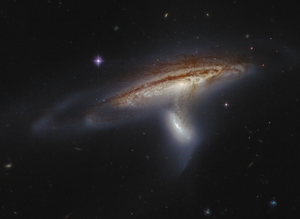
Back Gezeitenkraft ALS قوة المد والجزر Arabic Приливна сила Bulgarian Força de marea Catalan Slapová síla Czech Тулăмла вăйсем CV Tidevandskraft Danish Gezeitenkraft German Παλιρροϊκές δυνάμεις Greek Tajda forto Esperanto

The tidal force or tide-generating force is a gravitational effect that stretches a body along the line towards and away from the center of mass of another body due to spatial variations in strength in gravitational field from the other body. It is responsible for the tides and related phenomena, including solid-earth tides, tidal locking, breaking apart of celestial bodies and formation of ring systems within the Roche limit, and in extreme cases, spaghettification of objects. It arises because the gravitational field exerted on one body by another is not constant across its parts: the nearer side is attracted more strongly than the farther side. The difference is positive in the near side and negative in the far side, which causes a body to get stretched. Thus, the tidal force is also known as the differential force, residual force, or secondary effect of the gravitational field.
In celestial mechanics, the expression tidal force can refer to a situation in which a body or material (for example, tidal water) is mainly under the gravitational influence of a second body (for example, the Earth), but is also perturbed by the gravitational effects of a third body (for example, the Moon). The perturbing force is sometimes in such cases called a tidal force[2] (for example, the perturbing force on the Moon): it is the difference between the force exerted by the third body on the second and the force exerted by the third body on the first.[3]
Tidal forces have also been shown to be fundamentally related to gravitational waves.[4]
- ^ "Hubble Views a Cosmic Interaction". nasa.gov. NASA. February 11, 2022. Retrieved 2022-07-09.
- ^ "On the tidal force", I. N. Avsiuk, in "Soviet Astronomy Letters", vol. 3 (1977), pp. 96–99.
- ^ See p. 509 in "Astronomy: a physical perspective", M. L. Kutner (2003).
- ^ arXiv, Emerging Technology from the (2019-12-14). "Tidal forces carry the mathematical signature of gravitational waves". MIT Technology Review. Retrieved 2023-11-12.